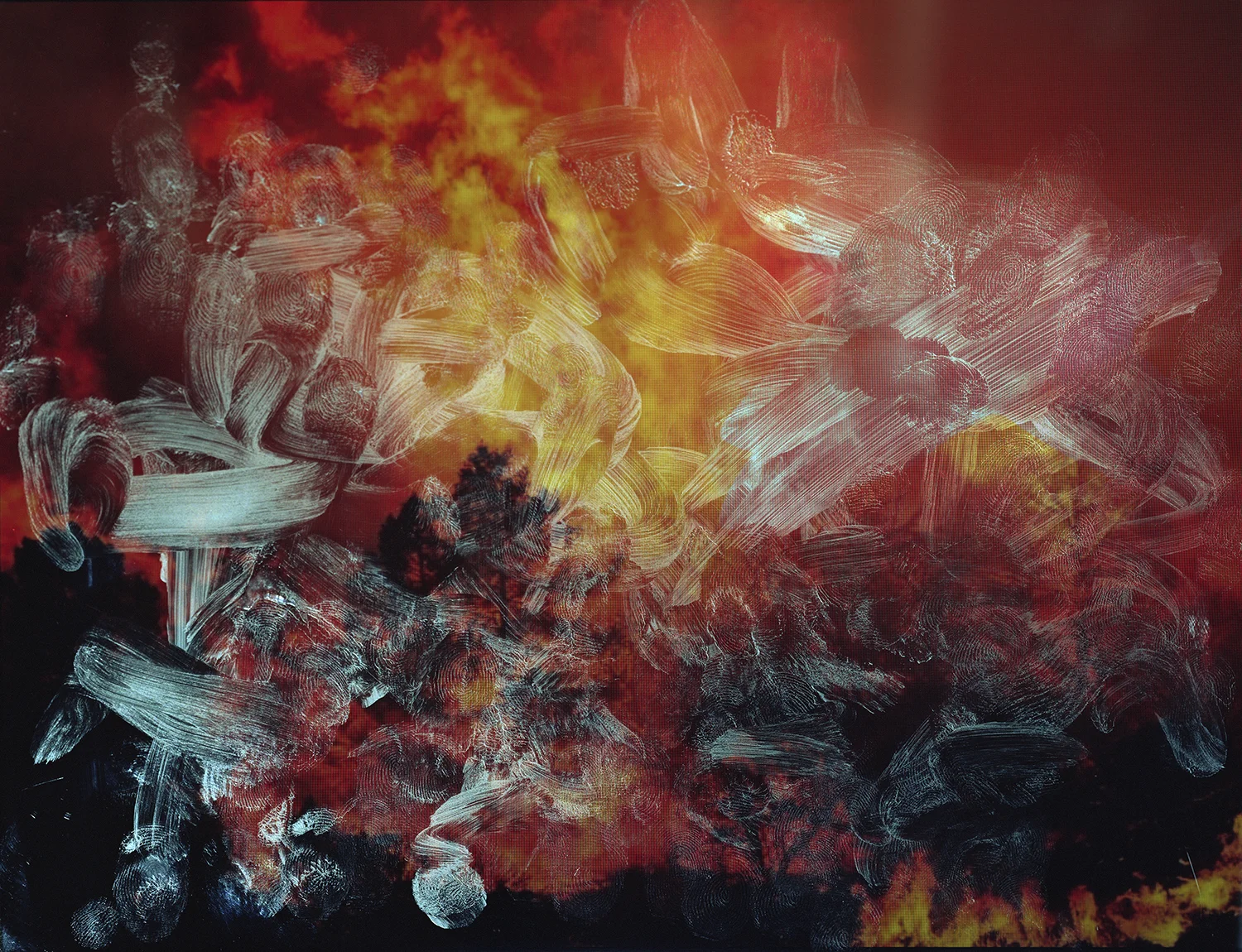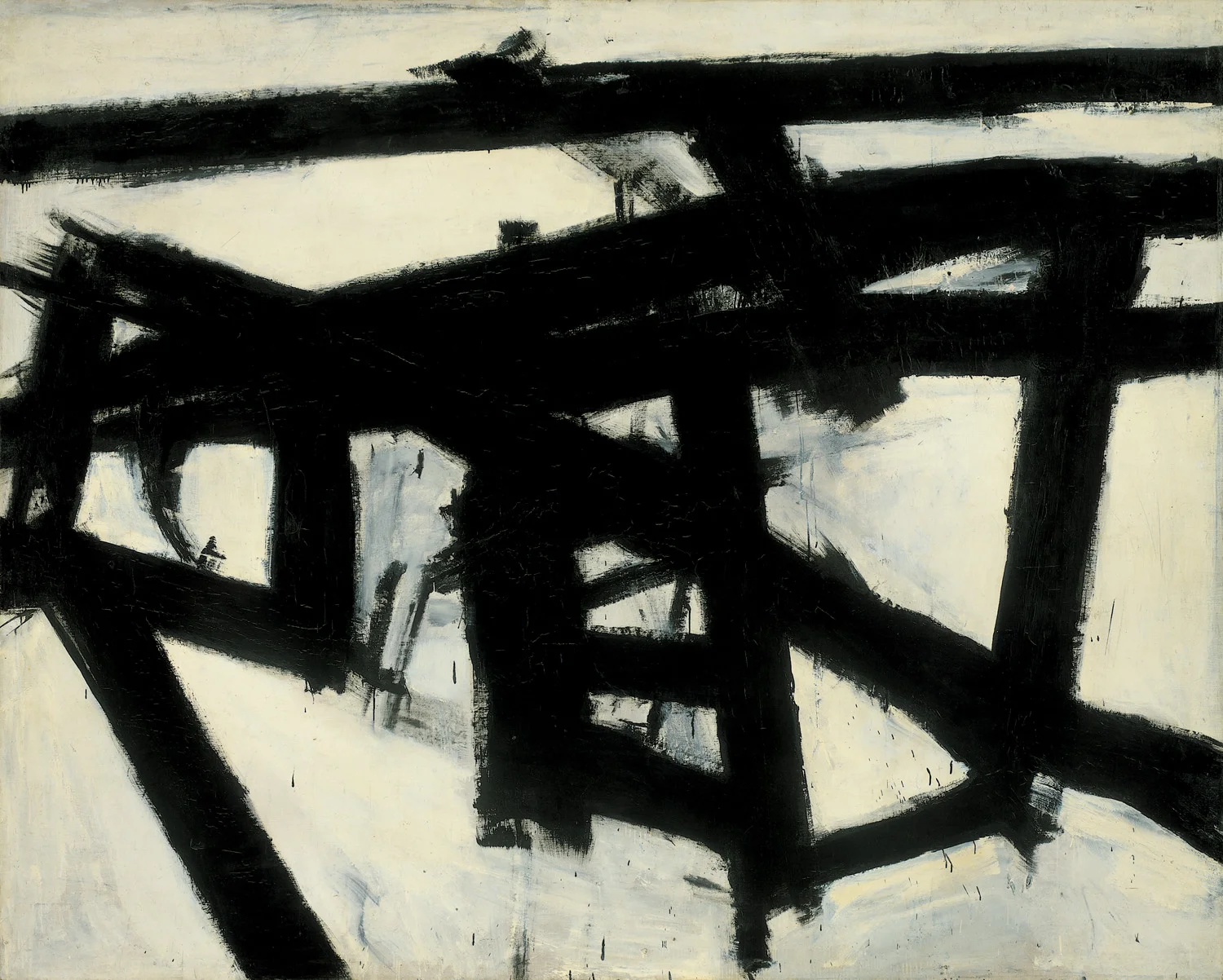Emailed Kiss Goodnight © Tabitha Soren
Three years ago, while on a redeye flight, '90s news reporter-turned photographer Tabitha Soren was reading a PDF on her iPad to pass the time. By the fourth chapter, the lamp above her seat was her only source of light, and at a certain angle she noticed it illuminating strange lines across the screen. As she continued reading, these lines grew into convoluted, gestural smudges – her fingerprints abstracted from continuous scrolling as she repeated the same motions over and over again. “At the end of the fourth chapter,” says Soren, “they had accumulated enough that I almost wiped the screen clean of them so I could read more easily, but before I did that I noticed how beautiful the marks were.” And thus began Surface Tension, a series of photographs that pulls apart the many layered ways people consume and engage with images online.
HUFFINGTONPOST.COM/2014/08/20/LAKE-TAHOE-WILDFIRES © Tabitha Soren
Mahoning (1956) © Franz Kline (Fair use via WikiArt)
“The Patterns reminded me of a Franz Kline painting,” says Soren, referencing the aggressive strokes that stretched across the mid-twentieth century painter’s canvases. Soren initially made a few snapshots of the iPad smudges with her iPhone before ultimately photographing the screens in a controlled environment with black and white film in her medium-format Hasselblad. Not much came of these, which Soren felt were “too beautiful and serene” and seemed dated in black and white. She shifted to color photographs made with an 8x10 view camera, sandwiching the new, mobile technology with the tone and detail rich capabilities of sheet film. “The color screens do a better job replicating the agitation I feel when I’ve spent too much time with technology,” she says. As many of her earlier projects address what she describes as “visualizing psychological states,” and color provided the necessary multidimensionality to make this work.
TED.COM/TALKS/JULIAN_ASSANGE_WHY_THE_WORLD_NEEDS_WIKILEAKS?LANGUAGE=EN © Tabitha Soren
GALEGROUP_POGROMS © Tabitha Soren
TRUTHOUT_ORG_FERGUSON_OHIO © Tabitha Soren
The actual pictures that live beneath the surface of smudges are not Soren’s own. They’re pulled from social media and various web searches for material and references that are consistently on her mind. Random images shared by Soren’s friends and family hang in the same visual conversation as screengrabs from news videos and images that are accessible in the public domain, and their titles correspond to the links in the pictures themselves. For example, Soren places an image titled TED.COM/TALKS/JULIAN_ASSANGE_WHY_THE_WORLD_NEEDS_WIKILEAKS?LANGUAGE=EN in the same context as Emailed JPG of DAD, images pulled from a website archive memorializing Pogrom victims, photos from Ferguson demonstrations, and a Tumblr dedicated to Sonic Youth.
“I think having so many sources emphasizes that people are becoming far more visual than verbal,” she says. “We are all using images as language – emoticons come to mind, so does Instagram -- but this linguistic use of images requires a complicated dance of the fingers, a repertoire of gestures that work best when invisible and unnoticed.” For Soren, the act of photographing these physical movements encourages viewers to address how heavily confined our attention and communication is to these devices, and correspondingly, how easy it is - with a fingerprint as metaphor - to track and monitor at all times. They also nod to early experiments in photographic history, namely Eadweard Muybridge’s motion studies of horses, and athletes, as Soren freezes, and makes visible, the repetition of these daily movements.
© Edweard Muybridge. Courtesy of the Library of Congress
Phone Photo From Last Night © Tabitha Soren
TUMBLER FCK YEAH © Tabitha Soren
While it’s not the main focus in these images, there is a subtle relationship between Soren’s iPad interventions and the time she spent in her twenties as a on-air correspondent for MTV News, CNN, and NBC. During this time, she was not only reporting, but writing scripts, composing shots, and ultimately working as what she describes as a “one man band reporter.” While her first career was largely pre-internet, she was involved in composing and directing a constant stream of images geared at public consumption so people would respond to, and engage with her stories. At once responsible for engineering how we understand the world, in her second act, she’s found a way to pull its evolution apart at its glassy seams.
MOVIE_PILOT_COM_LONG_TIME_DEAD © Tabitha Soren
INSTAGRAM.COM/ANISHA_K © Tabitha Soren
DROPBOX.COM/HOME/FAMILYSNAPS © Tabitha Soren
WISHI’DKILLEDHIM/TWICHTY.COM/OKLAHOMATROOPER © Tabitha Soren
Bio: Tabitha Soren left a career in television in 1999 to start another as a photographer. Her work is about the internal weather that storms though each of us. Public collections include the Los Angeles County Museum of Art, Oakland Museum of Art, Transformer Station, Pier 24 Photography, New Orleans Museum of Art and the Ogden Museum of Southern Art. She is represented by Kopeikin Gallery in Los Angeles. Her first photo book, FANTASY LIFE, will be published by Aperture in the spring.
Story by Jon Feinstein













